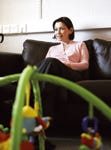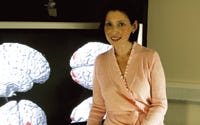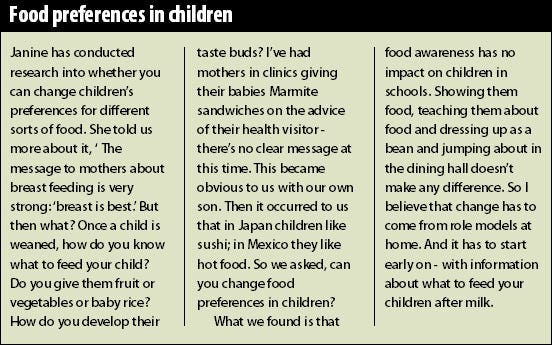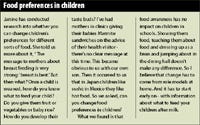]> Janine SpencerIt was a chance introduction at a marketing conference that resulted in Dr Janine Spencer becoming draw
April 6, 2018

]>

Janine Spencer
It was a chance introduction at a marketing conference that resulted in Dr Janine Spencer becoming drawn into the world of television and consumer products. A developmental psychologist, Janine trained at the London School of Economics and the Medical Research Council's Cognitive Development Unit at UCL, where she received her PhD. She now lectures in psychology at Brunel University and is director of the Centre for Research into Infant Behaviour (CRIB), one of a small number of baby labs in the UK. Her studies are principally of babies' and young children's social and cognitive development and she has been working with babies for ten years.
Janine's 'discovery' by the licensing industry is timely: it coincides with the upsurge in public opinion and government interest in the way we market products to children. It also coincides with pressure on new TV programmes to achieve 'standout' in a very crowded market place. Janine's experience with her own young son has inspired her to undertake additional research into children's eating preferences.
Janine has acted as consultant for companies like Mothercare and Granada. She sits on the board of creative consultancy, Kids Industries, and has spoken for the Marketing Society. She says that making the leap from academic research to the field in which it is eventually applied is both fascinating and essential.
Amidst the incongruous mix of academic journals and the baby toys and paraphernalia that litter her office, we talked about why it's so important for our industry to understand how babies and young children develop and about how it can improve a brand to do so.
Explain your particular area of research.
I specialise in visual processing, in other words how babies learn to see and therefore how they learn to communicate socially in the world. From just moments after our birth we are learning how to visually process faces; faces are the first shapes we learn. We also know that it is the dynamic of a face that attracts a baby-and if you think about it we very rarely see a static face. My research also investigates how babies learn to categorise objects. A baby from four months old, for example, can already put dogs, trees, people, etc, into categories. 
Why is it so important to understand about categorising objects?
Because it applies to everything we see; food, people, television programmes, etc. Categorising starts at a perceptual level; as babies get older they develop and practise it and we become more expert at it as we get older. Toys and TV for young children can help develop these important skills.
Why is it important for people in the kids business to learn about something as detailed as visual processing?
In the supermarket children recognise Thomas, for example, because everything else is unknown to them. Thomas also stands out on the shelf because it has a face. Adults are very good at picking through visual noise and stimuli but children have to learn how to do that. Being a baby is like being in a foreign place where you don't understand anything going on or being said around you. So you quickly fix onto something you recognise. It's very important to understand how this processing develops.
So what is it that makes a child know that the train is Thomas?
Well Thomas has a face, for a start and facial recognition is one of the first things we learn. A train without a face is just a train. 
Could a baby's ability to recognise a face have an impact on its devotion later on to particular characters?
Yes, because we are especially drawn to faces and the outlines of faces. Pooh, for example has a very distinct outline. The visual system finds outlines of faces first and then only if it sees two outlines that look the same will it look at texture in order to distinguish between them.
So you could get it all wrong by producing a character with a poor face?
Yes!
How does a new brand make sure it gets all this right?
We have learnt how to make new things stand out by accident, but if you're starting with a new brand you should start by taking one thing into consideration and it will all come together. For example, with a toy, you must take into account the way that a child sees, and it's not just colour but also tone. In fact the child might just see "bright" rather than red or blue if both colours are very bright.
You must also consider that if you want a child to attend to something very briefly you use one way to get their attention but if you want it to entertain them for a long time, you use a different method. It echoes advertising – an adult couldn't watch a whole feature film made like an advert.
Just how much can a TV programme maker think about all those things – colours, shape, age group?
There's a huge amount to think about but it does start to fall into place when you start to take one thing into consideration. It's not that difficult, it is just a matter of understanding how children think.
Can you think like a child?
It's hard as an adult to remember being a child and to put yourself back into the mind of a child. You don't want to make a programme the way you remember your childhood. Although children don't change in terms of cognitive development things around them do change. Children understand that they learn from adults, so talk to a child as an adult would. Don't patronise them by making adults behave like children, for example. Children do learn from children but they learn more from adults and they do know this.
Why did Granada want your help with Pocoyo?
Pocoyo was a great example to work on. Granada wanted input from someone who knew about child development and visual perception, to help them make the programme visually appealing to children. In Pocoyo there is no visual clutter at all, in fact there's a nearly totally bare background. It's a striking contrast, for example, with a show like the Tweenies, where there is lots of colour and clutter, and education of a different sort. Each episode of Pocoyo has a developmental aspect to it, even if it's something very simple. It also has a very slow pace. Pace is important for young children and speed is not necessarily what holds a child's attention.
Did your work have any impact on the consumer products?
Yes. One question we considered was whether it was OK for children to take the head off a Pocoyo bubble bath bottle, for example. (How will the child know how to open the bottle? Take his hat off.) It's probably OK for children, but not necessarily a good thing for the brand! You do have to consider things from every point of view.
Which children's TV shows do you most admire?
I think Sesame Street is amazing and also the Pixar films. They are watchable for children and for adults, which is very important-although we all do it, you don't really want to just plonk your child in front of the TV. It's better to watch it with them. I find Leapfrog's DVDs are also very good. My son, Dominic, wanted Shrek for Christmas. Interestingly, Shrek is a very particular character with a very human, animated face. And my own favourite programme is Star Trek – I'm a huge trekkie! 

Is TV a positive thing for children?
I think TV can be a very good thing for children's development. It gets a bad press because it can be very passive, but it doesn't have to be. TV can be highly interactive, not in the red button sense of the word but by stopping you doing what you're doing and asking the child a question. Passive TV can be good for slowing children down before bedtime but it's not good for learning or developing.
Is there such a thing as too much TV?
Yes. You can have too much visual stimulation. TV can be visually stimulating while being cognitively unstimulating at the same time. The thinking part of the brain is almost in a sleep state when it's watching TV so that the brain is looking but not attending.
Tell us more about the work you've been doing with Mothercare.
With Kids Industries we were investigating whether toys can hit developmental milestones. Rather than saying 'suitable for age 2-3' on the packaging, for example, it might be better to indicate that a child of six months might find this toy interesting visually, but not get much cognitive development from it until later. We wanted to create a guide to show which toys effect the child's cognitive and/or visual development at which stages. Often you don't know what to buy for a child and there's a big difference between being 30 and 36 months old. Many two and a half year olds don't like jigsaw puzzles but three year olds really get it, for example.

You've also been working on the new Hit Radio station?
Yes, it's a very interesting project. If you've got a whole day of programmes, you have to ask, what can you do? What can children of different ages get from the radio? How do you encourage imagination and stop them tuning out?
And what can very young children get from the radio?
If you've got really good narrative and stories they will get a lot, especially if they have good rhythm. Things like The Gruffalo, or Dr Seuss-children love the rhythm of them. If you think about how children learn language they might not understand the words, but they pick up the rhythm. Radio can do this really well and the children can do something else while they listen.
Is our industry really trying to understand your kind of research or is it just paying pay lip service to it?
I think it is taking it on board. Understanding about child development can lead to both fundamental changes and fine tuning in a TV show. More so now than ever before, you have to make a TV programme educational. And there's a difference between asking educational and developmental psychologists to help you. The result is the difference between school education and a curriculum, or a more general look at development in young children. In the future, we'll see different sorts of TV programmes based on different expertise that feeds into a show. Personally, I think we should get away a bit from curriculum and remember that all learning is good.
Why is our industry interested in your work now; why do we 'Have to become more educational'?
Because society is increasingly interested in how children develop. Every parent wants the best for their child. And because if TV can be good, it might as well be.
Do you see programmes and wonder how they ever got made?
Yes. But I don't think it would be wise to say which ones! Years ago, toys or programmes might have been selected on the basis of personal choice (the MD's kids like it, for example) or whim. Now things are too competitive for that, and we understand far more. So why not make the selection process more rigorous?
The market for developmental toys has exploded recently but isn't it just as useful for a baby to play with a bunch of keys than an expensive educational toy?
Yes, they are noisy and fun. But playing with keys won't teach a child very much. Children can learn through play. If we can create an ethos where learning is fun, children will learn more so you might as well make toys educational. 

Does this assume that it's OK to market toys and other products very specifically to children?
Remember that children have always wanted things whether they are advertised or not. Young children are attracted to novelty because that's how they learn. When you test children you find that they are drawn to any new object you introduce into a group of familiar objects. Adults are just the same! I think the industry should stop feeling guilty about selling to kids, because kids want things. And we should stop feeling guilty about being overtly educational.
What's your final message to the consumer products business?
Learn about children's brain development. Learn about what they see and how they learn to think, speak and communicate. It may have been OK in the past to ignore children's perception when developing children's programming and products, but considering it will make your brand better.
You May Also Like






